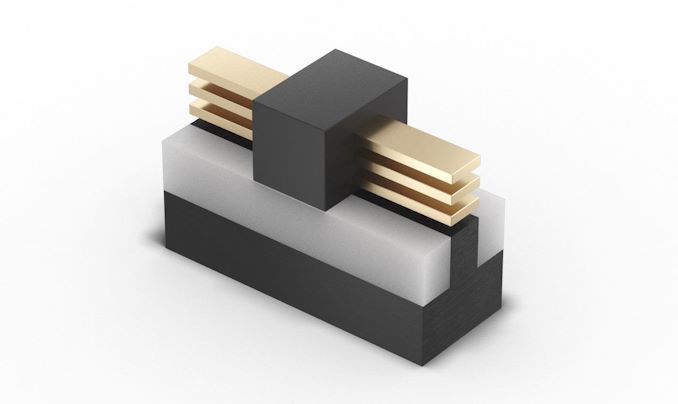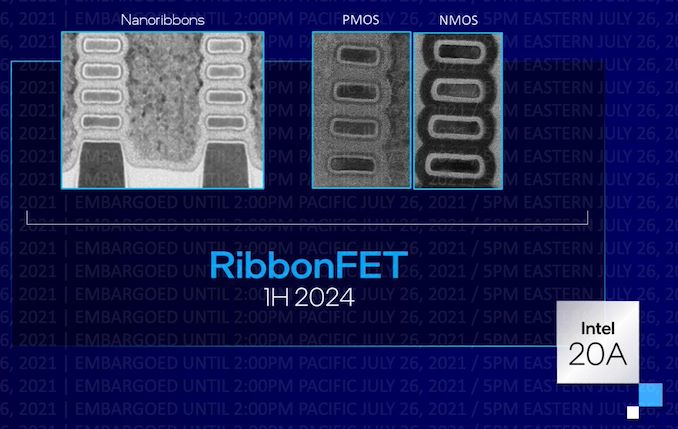Intel’s First High-Profile IFS Fab Customer: Qualcomm Jumps on Board For 20A Process
by Ryan Smith on July 26, 2021 6:00 PM EST
Alongside Intel’s sizable announcement today regarding their manufacturing roadmap over the next half-decade, the company is also announcing their first major customer for their third-party foundry service, IFS. And in an example of how Intel’s entry into the contract fab business is going to make for some strange bedfellows, it turns out that major customer is Qualcomm.
Per Intel’s announcement, Intel and Qualcomm are partnering up to get Qualcomm products on Intel’s 20A process, one of the company’s most advanced (and farthest-out) process node. The first of Intel’s “Ångström” process nodes, 20A is due in 2024 and will be where Intel first implements Gate-All-Around (GAA) transistors, one of the major manufacturing technology milestones on Intel’s new roadmap.
Given that 20A isn’t due out for another three years, neither company is saying much more about the partnership at this point – we’re talking about chip designs that are still in their earliest stages – but even being able to name a major customer like Qualcomm is a big deal for Intel. Not only does it show that another major industry player has a degree of faith in what Intel is trying to accomplish with its silicon lithography technology, but it helps to validate Intel’s efforts to open up into the contract fab business.
Meanwhile, an announcement like this opens the door to all kinds of speculation over just what Qualcomm will be building over at Intel. Qualcomm is best known for their mobile SoCs, and the company already has significant experience using multiple fabs as a customer of both TSMC and Samsung. So it may be that Qualcomm is looking to build a mainstream mobile SoC or two at Intel as a way to get experience working with Intel and prove that Intel’s fabs will meet their needs. Alternatively, Qualcomm may be looking to take advantage of Intel’s PC-tuned manufacturing lines to produce Nuvia-infused laptop SoCs – which would mean Intel would be directly producing competing chips.
There are a lot of possibilities here over the long-run, though in the short-run it’s likely that Qualcomm is going to play things conservatively. So suffice it to say, it will be interesting to see just what Qualcomm is using their rival’s fabs for in a few years.
Qualcomm is excited about the breakthrough RibbonFET and PowerVia technologies coming in Intel 20A. We’re also pleased to have another leading-edge foundry partner enabled by IFS that will help the U.S. fabless industry to bring its products to an onshore manufacturing site.
-Cristiano Amon, President and CEO, Qualcomm
Source: Intel











59 Comments
View All Comments
Sahrin - Monday, July 26, 2021 - link
Giving Intel your IP is like having a child molester babysit your kids and leaving them a bottle of Viagra.TheinsanegamerN - Tuesday, July 27, 2021 - link
Since when is Intel Chinese?dotjaz - Tuesday, July 27, 2021 - link
Since you become a racist, so I guess forever then.Spunjji - Wednesday, July 28, 2021 - link
Is the implied hypothesis that only Chinese companies steal IP? You sweet summer child.JKflipflop98 - Friday, July 30, 2021 - link
No, but they're certainly the best and most prolific at it. Being as they have no real government regulations on the matter and they're free to rip off whatever trademark and copyright they see fit.mode_13h - Saturday, July 31, 2021 - link
> Being as they have no real government regulations on the matterI think there have been many credible allegations that the government actually perpetrated IP theft of strategic importance and funneled the IP to domestic producers.
There have also been many cases of individuals working abroad and taking IP from their employers or universities. I think I observed this firsthand, but could find only circumstantial evidence that wouldn't support raising such a serious allegation.
mode_13h - Tuesday, July 27, 2021 - link
That's not how it works. They don't send Intel the source code and say "build this". What they send to Intel is more like the commands your PC would send to a 3D printer. So much reverse-engineering would be needed to go from that to a comprehensible chip design that it wouldn't be worthwhile.Plus, anyone can shave down a die and look at it under an electron microscope, if they really want to see certain low-level details.
Sahrin - Tuesday, July 27, 2021 - link
This has to be the most deluded post I've ever seen.Unashamed_unoriginal_username_x86 - Tuesday, July 27, 2021 - link
Charcoal calling porcelain black. Why would anyone fab at Samsung if they get your IP when you fab with themmode_13h - Wednesday, July 28, 2021 - link
Please explain.